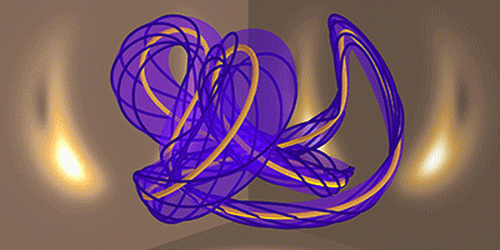October 18, 2013 report
Light knots: Physicists use Maxwell's equations to describe field lines that encode torus knots and links

(Phys.org) —A team of physicists, two from the U.S., and one each from Poland and Spain has used Maxwell's equations to describe field lines that encode all torus knots and links. As they describe in their paper published in the journal Physical Review Letters, the result of using the equations could lead to a method of creating light in the real world that can be tied into knots.
Maxwell's equations (named after James Clerk Maxwell) are a group of partial differential equations that have been used as the basis for developing virtually all modern electrical circuits and optic devices. Back in the late 1980's a team of mathematicians discovered several solutions to Maxwell's equations that described oddly shaped objects in free space that formed closed loops and that were linked together. They called their structures Hopf fibrations and they have since been found to exist in other areas of science such as the physics that describes liquid crystals.
In this new effort, the four physicists built on the previous work and have now found new ways to solve the equations that allow for describing beams of light traveling in the shape of torus knots and links. Torus knots are those kinds of knots that can lie on the surface of a close curve around a line that lies in the same plane, i.e. a torus. A link is a collection of torus knots. The light in the knots described by the solutions developed by the team hold on to their topographical properties and don't disperse. The solutions describe both magnetic and electrical field lines that ultimately control the way light propagates under certain circumstances.
The researchers suggest that creating real world knots made of light might be possible by applying their solutions in the lab using Laguerre–Gaussian beams—a type of beam that carries orbital angular momentum. If that were to happen, they suggest the resulting knots might be used to capture certain types of atoms. Also sending the knots into a plasma field could result in plasma taking on characteristics of the knot, giving researchers a new way of studying the ionized gases.
More information: Tying Knots in Light Fields, Phys. Rev. Lett. 111, 150404 (2013). DOI: 10.1103/PhysRevLett.111.150404
Abstract
We construct analytically, a new family of null solutions to Maxwell's equations in free space whose field lines encode all torus knots and links. The evolution of these null fields, analogous to a compressible flow along the Poynting vector that is shear free, preserves the topology of the knots and links. Our approach combines the construction of null fields with complex polynomials on S3. We examine and illustrate the geometry and evolution of the solutions, making manifest the structure of nested knotted tori filled by the field lines.
Journal information: Physical Review Letters
© 2013 Phys.org



















